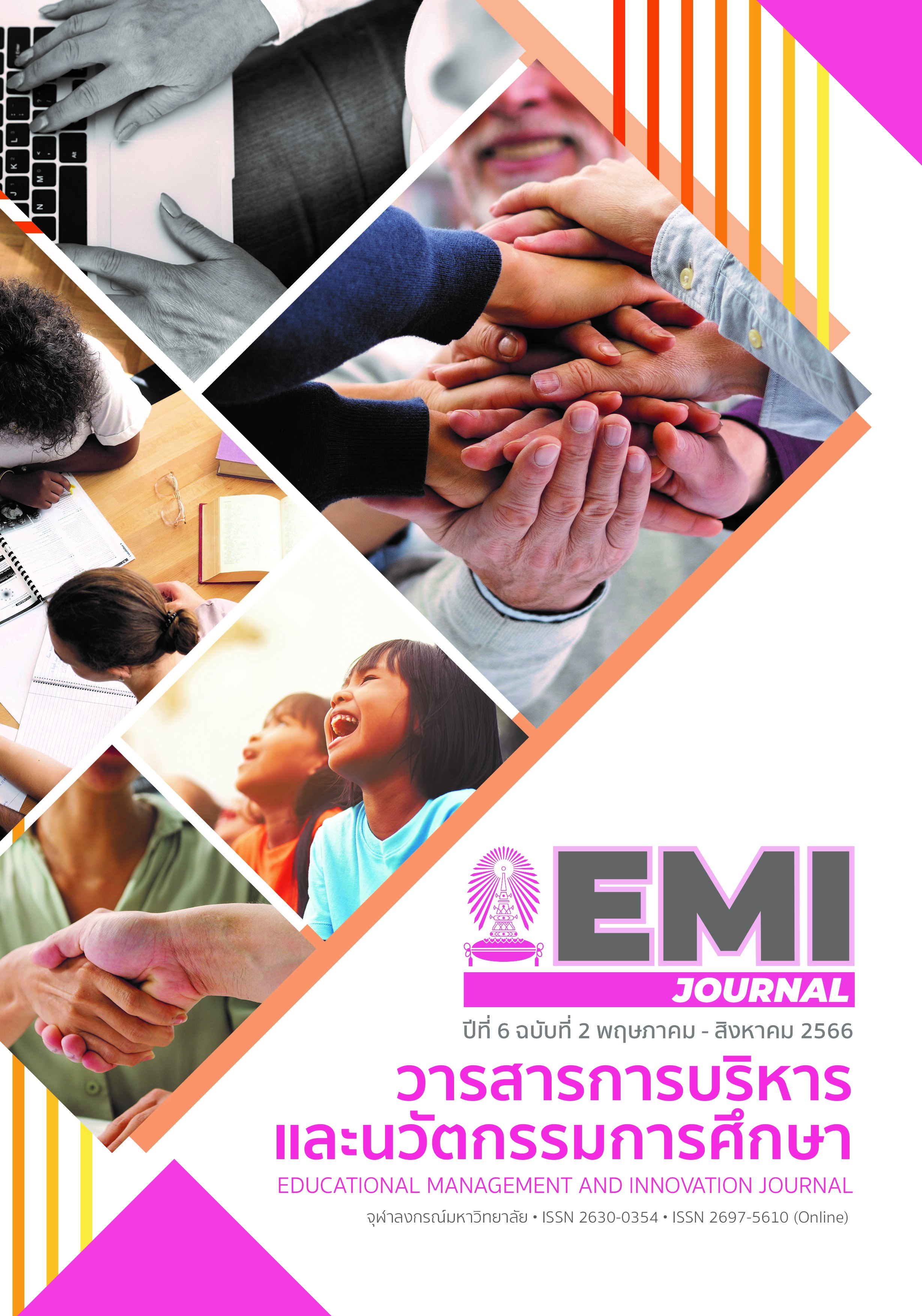Work-Integrated Learning: A Case Study on Occupational and Safety Program, Ubon Ratchathani Rajabhat University
การจัดการเรียนการสอนแบบบูรณาการกับการทำงาน กรณีศึกษา สาขาอาชีวอนามัยและความปลอดภัย มหาวิทยาลัยราชภัฏอุบลราชธานี
คำสำคัญ:
การเรียนการสอนแบบบูรณาการบทคัดย่อ
การศึกษานี้มีวัตถุประสงค์เพื่อออกแบบและศึกษาผลการจัดการเรียนการสอนแบบบูรณาการ สำหรับนักศึกษาสาขาอาชีวอนามัยและความปลอดภัย คณะสาธารณสุขศาสตร์ มหาวิทยาลัยราชภัฏอุบลราชธานี ทำการศึกษาระหว่าง พ.ศ. 2559-2562 จำนวนกลุ่มตัวอย่าง 84 คน เก็บรวบรวมข้อมูลโดยใช้แบบสอบถาม วิเคราะห์ข้อมูลด้วยสถิติเชิงพรรณนา ผลการศึกษาได้รูปแบบการจัดการเรียนการสอนแบบบูรณาการสำหรับนักศึกษระดับชั้นปีที่ 1-4 ได้แก่ 1) การกําหนดประสบการณ์ก่อนการศึกษา 2) การปฏิบัติงานในภาคสนาม 3) การเรียนรู้จากปัญหา 4) การปฏิบัติงานจริงในสถานประกอบการ 5) การฝึกงานเฉพาะตําแหน่ง และ 6) การฝึกปฏิบัติจริงภายหลังสําเร็จการเรียนทฤษฎี ผลการจัดการเรียนการสอนในรูปแบบดังกล่าว มีผู้สำเร็จการศึกษาระดับปริญญาตรีตามกรอบมาตรฐานคุณวุฒิระดับอุดมศึกษาแห่งชาติ ร้อยละ 94.12 มีงานทำร้อยละ 96.08 ระดับความพึงพอใจของผู้ที่สำเร็จการศึกษาจากการออกแบบการจัดการบูรณาการ
การเรียนการสอนควบคู่กับการทำงานและกับคุณลักษณะบัณฑิตที่พึงประสงค์ มีคะแนนค่าเฉลี่ยเท่ากับ 4.66 และ 4.58 (ระดับมากที่สุด)
Downloads
เอกสารอ้างอิง
Burkle, M. (2013). E-Learning challenges for polytechnic institutions, Bringing E-mobility to hands-on learning. SAIT Polytechnic, Canada, 18.
Chaiyasain, C. (2017). Development of work integrated learing together with a new theachinnovation, a case study of the food and beverage business operations and management course of faculty of Hospitality and tourism, Prince of Songkla university Phuket campus. Panyapiwat journal, 9(3), 266-276.
Coco, M. (2000). Internships: a try before you buy arrangement. Advanced Management journal, 65(2), 41-47.
Department of healt and age care. (2013). Review of Australian government health workforce programs: 7.1 nursing and midwifery education. Retrieved from https://www1.health.gov.au/internet/main /publishing.nsf/Content/health-publicat.htm
Kwunsakul, K. (2017). The study evaluation result of cooperative course curriculum in educational technology and communications, Facculty of education, Mahasarakham university. Journal of Educational Measurement Mahasarakham, 23(2), 19-32. [In Thai]
Kanchanapiboon, K., & Phoemphian, T. (2016). Practical guidlines on Work-integrated learning according to the desirablecaracteristics of the students in bacheral degree of Business administration and the enterprises’ needs. Panyapiwat Journal, 8(3), 165-177. [In Thai]
Kerdhan, T., Jantra, C., & Ekwarangkoon, P. (2021). An Evaluation of cooperative education project, Bangkok University. Journal of Modern Learning Development, 6(5), 127-141. [In Thai]
Katisart, N., Kuleelung, T., Dechanubeksa, N., Thatsanaphak, T., Boonjungcharoenrat, N., & Thongkam, P. (2021). Strategies for development of work integrated learning for Digital Business program. Rajabhat Maha Sarakham University Journal, 8(1), 365-375. [In Thai]
Kolb, A., & Kolb, D. (2013). The kolb leaning style inventory - version 4.0 a comprehensive guide to the theory, psychometrics, research on validity and educational applications. Experience Based Learning Systems, 1-230.
Kramer, M., & Usher, A. (2011). Work-Integrated Learning and Career-ready Students: Examining the Evidence. Higher Education Strategy Associates Intelligence Brief.
Meakin, K. (2010). The Benefit of Work Placement in Tertiary Design Education. DIT LTTC Graduate Student Conference, 1-22.
Merkel, S., & Jenkins, J. (2013). Work placement as an effective learning experience for undergraduate students; work-based learning and professional competencies, a reflection by case study, Proceedings of the 49th ASC Annual International conference, Associated schools of construction, 1-8.
Ministry of higher education science research and innovation. (2021). Government Action Plan Yearly 2021 of the Ministry of Higher Education, Science, Research and Innovation, 1-138. [In Thai]
Office of the higher education commission, (2018). Work-Integrated Learning mannual. Cooperative and work integrated education. Cooperative education development network in the upper south,
-182.
Papol, R., & Talanuek, D. (2018). Work integrated english leraning of Otop inno-life tourism based communities. Journal of graduate studies review Mahachulalongkornrajavidyalaya University, Phrae campus, 4(2), 181-191.
Stirling, J., Palazzo, G., & Phillips, R. ( 2016). Historic corporative social responsibility. Academy of management review, 41(4), 700-719.
Science of technilogy section royal Thai embassy in Beijing. (2021). The current situation and the future of Thai education. Retrieved from https://www.stsbeijing.org/contents/16568.7
Thummake, P., & Sasen, S. (2021). The development guidline toward the ideal caracteristic of the graduates according to the quailifications framework of undergraduate students in the public administration program, Ubon Ratchathani Rajabhat University. Journal of MCU Ubon Review, 6(1), 147-158. [In Thai]
Talanuek, D. (2021). Work integratedEnglish Learning for Community-Based Tourism Services under Community-Based Tourism: OTOP Inno-life Project in Chiang Rai Province. MBU Education, 9(1), 173-191. [In Thai]
Taneerat, W. (2021). Effectiveness of Work-integrated learning model: Case study on project formulation and policy analysis course. Journal of education and innovative learning, 1(2), 141-156. [In Thai]
Yawai, A., Vongchavalitkul, N., & Chotipurk, A. (2018). The Establishment of Work Integrated Learning System of the Twelfth Grade Students. Sikkha Journal of Education, 5(1); 16-33. [In Thai]
Zettinig, P., Aleem, M., Majdenic, D., & Berry, M. (2022). An Integrative learning design for international business in a complex dynamic world. Journal of Management Education, 46(3), 531–557.
ดาวน์โหลด
เผยแพร่แล้ว
ฉบับ
ประเภทบทความ
สัญญาอนุญาต
ลิขสิทธิ์ (c) 2023 วารสารการบริหารและนวัตกรรมการศึกษา

อนุญาตภายใต้เงื่อนไข Creative Commons Attribution-NonCommercial-NoDerivatives 4.0 International License.



